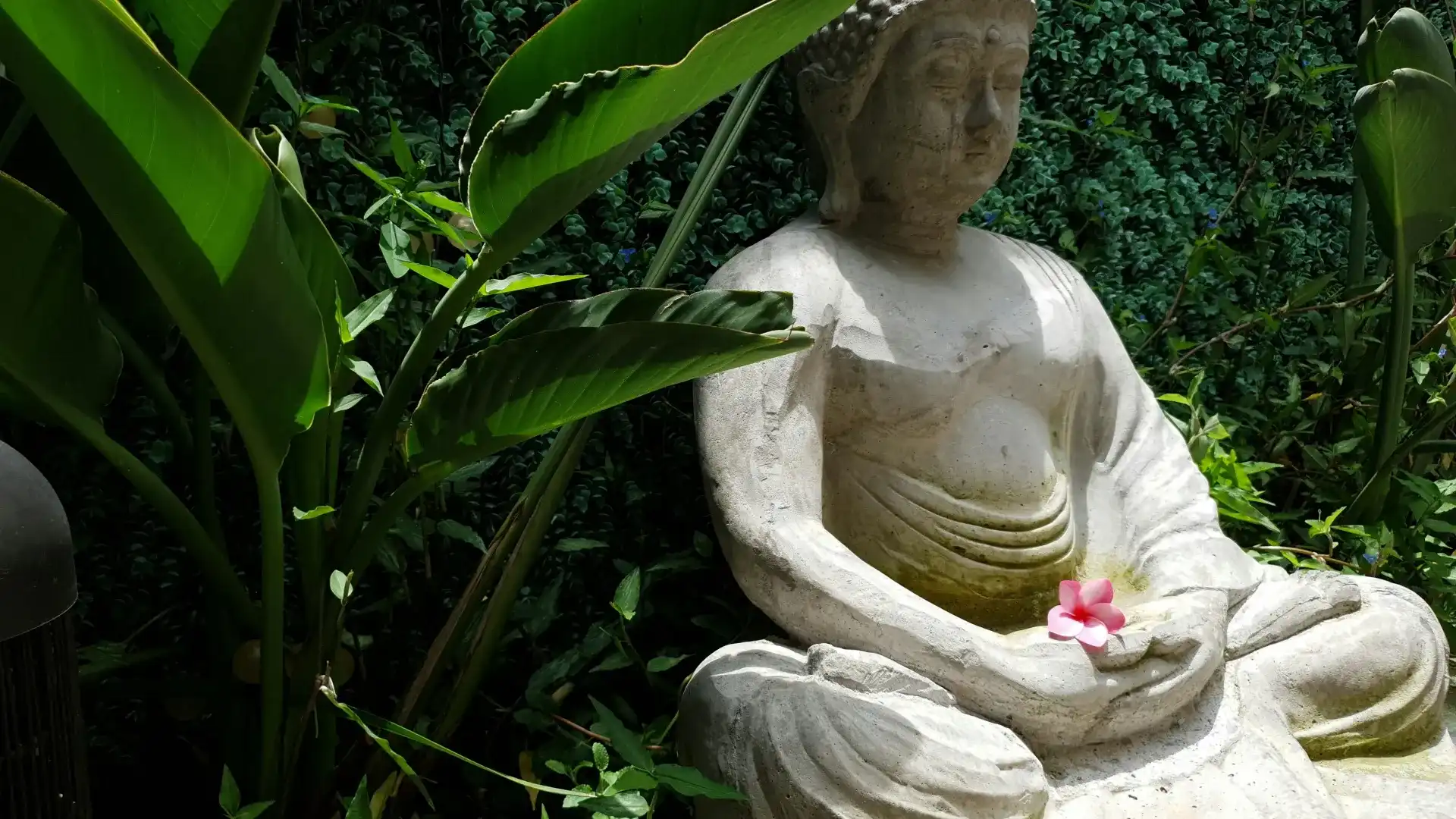Embryonic breathing is a Taoist meditation technique that promotes relaxation, focus, and inner balance through gentle, mindful breathing. It centers on the lower dantian (an energy point in the lower abdomen) and emphasizes effortless, natural breathing. This practice is rooted in ancient Taoist principles like Wu Wei (effortless action) and aligns with modern studies showing benefits for stress relief, emotional regulation, and physical well-being.
Key Benefits:
- Physical: Reduces tension, improves breathing efficiency.
- Mental: Lowers stress, enhances focus.
- Spiritual: Boosts self-awareness and harmony.
How to Start:
- Posture: Sit comfortably with a straight spine, relaxed shoulders, and hands resting on your lap.
- Breathing: Focus on your lower abdomen, inhale gently, and exhale naturally. Keep your chest still.
- Practice: Begin with 5–10 minutes daily and increase gradually.
Quick Tips:
- Avoid forcing your breath or straining.
- Practice in a quiet, uncluttered space.
- Track your progress to stay consistent.
Embryonic breathing combines ancient wisdom with practical techniques for modern stress management and mindfulness. Start small, stay consistent, and let the practice naturally enhance your well-being.
Embryonic Breathing Technique: Qigong and Breathwork Practice
Scientific Background
Recent studies on slow and mindful breathing techniques have shed light on the physiological and psychological effects of embryonic breathing - a practice with roots in ancient traditions. These findings align with traditional claims about its overall benefits.
Physical Effects
Embryonic breathing encourages a steady, calming rhythm by fully engaging the diaphragm. This helps reduce muscle tension and allows for extended, low-risk practice.
Medical Studies
Short-term practice has been shown to promote relaxation, while long-term use improves respiratory efficiency and builds resilience to stress. Early neuroimaging studies suggest that consistent practice can lead to changes in brain areas responsible for emotional regulation and self-awareness. This supports traditional views on the deep connection between the mind and body, setting the stage for the practical techniques discussed next.
Learning the Technique
Setup and Position
Choose a quiet area with a comfortable temperature (68–72°F) and a firm surface like a yoga mat or cushion.
Here’s how to position yourself for the best results:
- Sit cross-legged, or if you prefer a chair, keep your feet flat and about 12 inches apart. Keep your spine straight, relax your shoulders, lower your chin slightly, and rest your hands on your thighs or lap.
- Place your tongue gently against the roof of your mouth.
Basic Instructions
Once you're in position, follow these steps:
-
Initial Preparation
Close your eyes and progressively relax your body. Spend 1–2 minutes simply observing your natural breathing. -
Core Practice
Focus your attention on the area 2–3 inches below your navel. Inhale slowly, allowing your lower abdomen to expand gently while keeping your chest still. Exhale naturally, letting the abdomen contract. Aim for 4–6 slow, steady breaths per minute.
Common Errors to Avoid
| Error | Impact | Solution |
|---|---|---|
| Forcing the breath | Causes unnecessary tension | Keep your breathing gentle and natural |
| Chest breathing | Reduces diaphragm movement | Concentrate on your lower abdomen |
| Irregular timing | Disrupts your breathing flow | Use a quiet timer to pace yourself |
| Poor posture | Restricts breath flow | Check your alignment regularly |
| Mental strain | Increases tension | Gently refocus on your breath if distracted |
Start with short sessions of 5–10 minutes, and as you become more comfortable, gradually increase the duration. Consistency and a relaxed approach are key to building skill over time.
sbb-itb-4c1eb9b
Daily Practice Methods
Building a Regular Schedule
Make embryonic breathing part of your daily routine by practicing for 5–10 minutes in the morning and evening. You can also add a quick 5-minute session at midday if needed.
| Time of Day | Duration | Focus Area |
|---|---|---|
| 6:00–6:10 AM | 10 minutes | Morning energizing practice |
| 12:00–12:05 PM | 5 minutes | Midday stress relief (optional) |
| 9:00–9:10 PM | 10 minutes | Evening relaxation |
These sessions help you seamlessly incorporate embryonic breathing into your day and pair it with other mindful habits.
Mixed Practice Options
If a strict schedule isn't your style, try blending embryonic breathing with other practices to enhance your overall well-being:
- Meditation: Begin with 3–5 minutes of embryonic breathing to settle your mind and focus.
- Qigong: Practice embryonic breathing during standing postures to encourage a sense of balance and flow.
- Yoga: Pair it with restorative poses or during Savasana to deepen relaxation and calm.
Stress Management Applications
Embryonic breathing can be a powerful tool for managing stress. Use it in short, focused sessions to regain control and composure.
"Mystery after mystery, Is the gate to all wonders." - Book of Tao
- Quick Relief: When stress hits, take a 30-second pause and focus on your lower abdomen.
- Stress Prevention: Before facing a challenging situation, spend 3 minutes practicing to create a sense of calm.
- Post-Stress Recovery: After a demanding task, take 5 minutes to restore balance and regain focus.
These strategies build on the foundational benefits of embryonic breathing, offering practical ways to stay centered throughout your day.
Problem-Solving Guide
Focus and Concentration
Maintaining focus requires a balanced approach. Here are some practical solutions for common focus issues:
| Challenge | Solution | Expected Result |
|---|---|---|
| Racing thoughts | Shift attention to your breath | Clearer and calmer mind |
| Environmental noise | Acknowledge sounds without judgment | Fewer distractions |
| Time pressure anxiety | Start with short, achievable sessions | Steadier focus and less stress |
If distractions arise, simply notice them and gently return your focus to your breath. This idea aligns with the Taoist principle of Wu Wei - a concept of effortless action and going with the natural flow.
Now, let’s tackle physical barriers to ensure your practice stays uninterrupted.
Physical Comfort
Physical discomfort can disrupt your practice. Try these adjustments to improve your experience:
Seated Position
- Use a firm cushion to lift your hips 4–6 inches off the ground.
- Keep your knees slightly lower than your hips to ease strain on your lower back.
- Let your shoulders relax and drop naturally away from your ears.
Standing Practice
- Stand with your feet shoulder-width apart.
- Keep a slight bend in your knees.
- Maintain a straight but relaxed spine.
Experiment with alternating between seated and standing positions to find what works best for you.
For a more consistent practice, consider adopting some enduring strategies.
Long-Term Practice Tips
Build a sustainable routine with these helpful tips:
Creating a Supportive Environment
- Set aside a quiet, dedicated corner in your home for practice.
- Keep the area tidy and free of clutter.
- Use soft, indirect lighting to create a calming atmosphere.
Tracking Your Progress
- Jot down how your body feels after each session.
- Record the duration and timing of your practice.
- Note any challenges you encounter and the solutions that prove effective.
These strategies can help you stay consistent and make the most of your practice over time.
Taoist Principles
This section explores the Taoist roots of embryonic breathing, connecting its practice to ancient wisdom about living in harmony with the Tao. Embryonic breathing reflects key Taoist ideas such as effortless action (Wu Wei), the dynamic balance of Yin and Yang, and the value of simplicity.
Natural Harmony
- Embryonic breathing follows gentle, natural rhythms that align with the patterns of nature.
- Each breath reflects the dynamic relationship between Yin and Yang energies.
- The practice promotes yielding over force, embodying the principle of Wu Wei.
Balance and Integration
This practice also highlights the Taoist focus on balance, integrating the body and mind seamlessly:
| Aspect | Physical Expression | Philosophical Meaning |
|---|---|---|
| Breath | Gentle inhalation and exhalation | Harmony of Yin and Yang |
| Posture | Relaxed yet attentive stance | Balance between effort and ease |
| Mind | Calm, focused awareness | Living in alignment with Wu Wei |
By practicing these principles, you enhance not only your breathing technique but also your overall sense of harmony and balance.
Simplicity in Practice
The straightforward nature of embryonic breathing reflects the Taoist emphasis on simplicity. Profound results arise from a direct and uncomplicated approach, mirroring the unembellished path central to Taoist thought.
Explore the Book of Tao

The Book of Tao offers translations of foundational Taoist texts and practical advice for weaving Taoist philosophy into daily life. These texts, dating back to approximately 2,500 years ago during China’s Warring States period (475–221 BCE), remain relevant today.
Key offerings include:
- Translations and interpretations of the Tao Te Ching
- Articles linking breathing practices to Taoist philosophy
- Practical tips for applying Taoist principles in everyday routines
The Book of Tao bridges ancient wisdom and modern practice, showing how embryonic breathing fosters simplicity, balance, and harmony.
Conclusion
Main Points
Embryonic breathing blends ancient Taoist teachings with modern stress relief techniques. It uses gentle breathing patterns paired with mindful awareness to promote physical relaxation and mental clarity.
The benefits include reduced stress, improved focus, and a sense of inner balance. These results align with the Taoist principle of effortless action, known as Wu Wei.
Getting Started
Here’s how to create a simple daily routine:
- Set aside 5–10 minutes in a quiet, comfortable spot.
- Focus on mastering basic posture and breathing before moving forward.
Short, consistent sessions are more effective than longer, irregular ones. Keep your breathing natural and unforced, reflecting Taoist ideas of simplicity and balance.
Learn more about Taoist breathing practices →
Approach the practice with patience, allowing your understanding to grow over time. This mindset helps transform embryonic breathing into a practical method for building inner peace and resilience.






